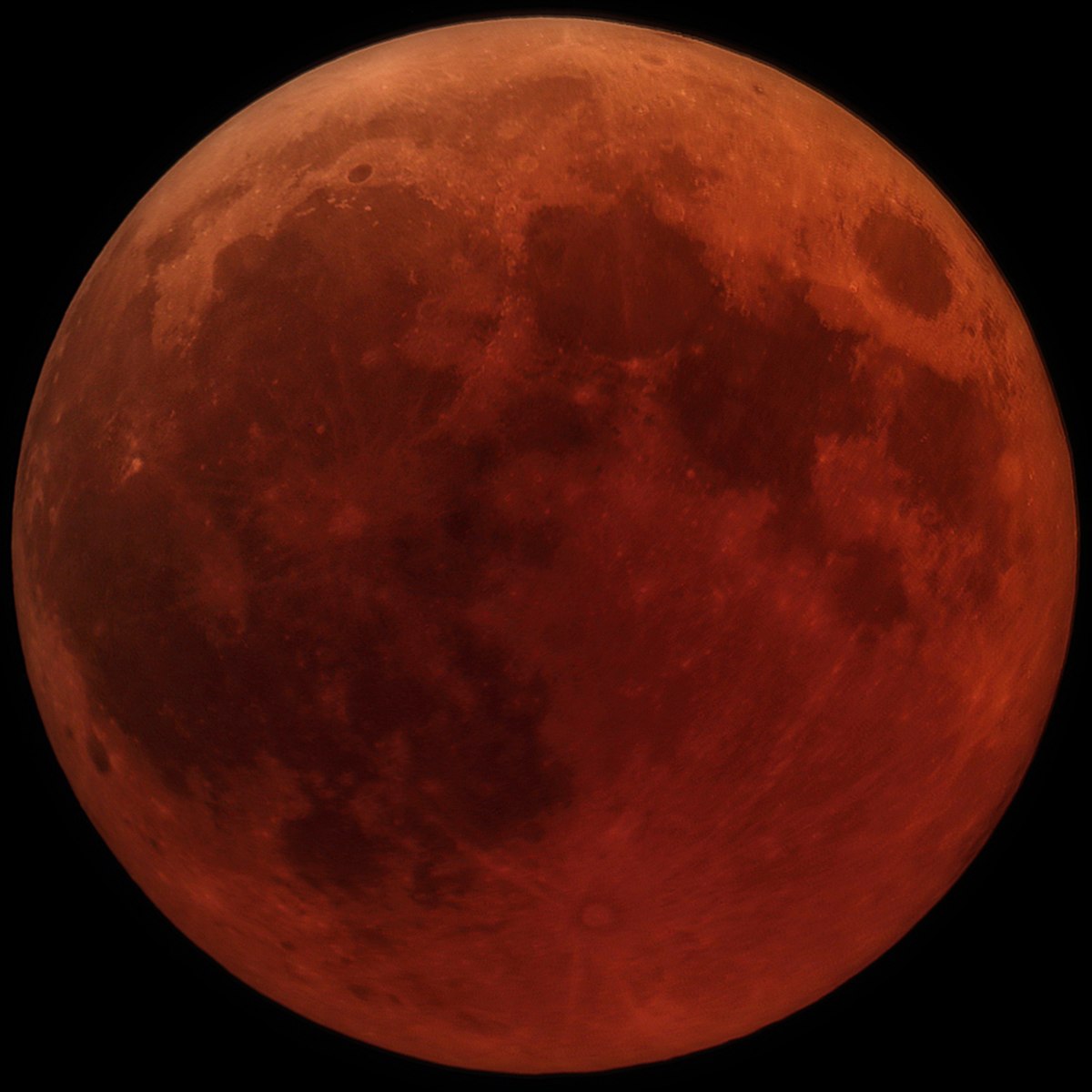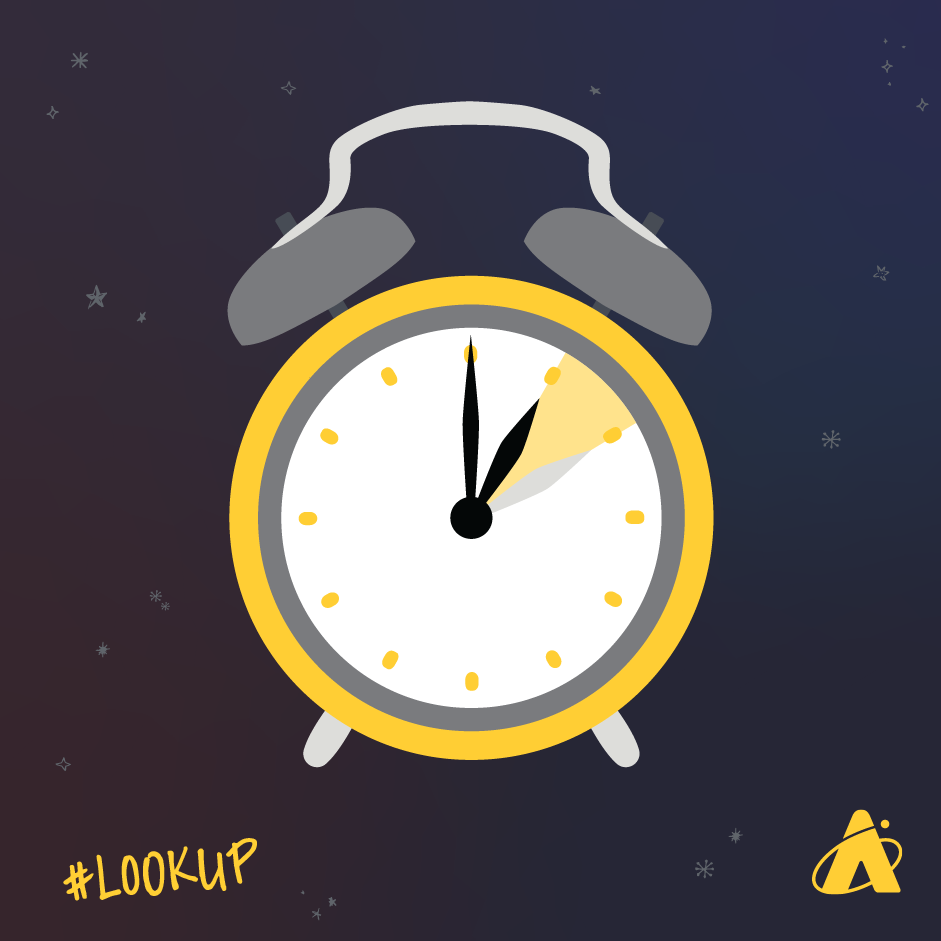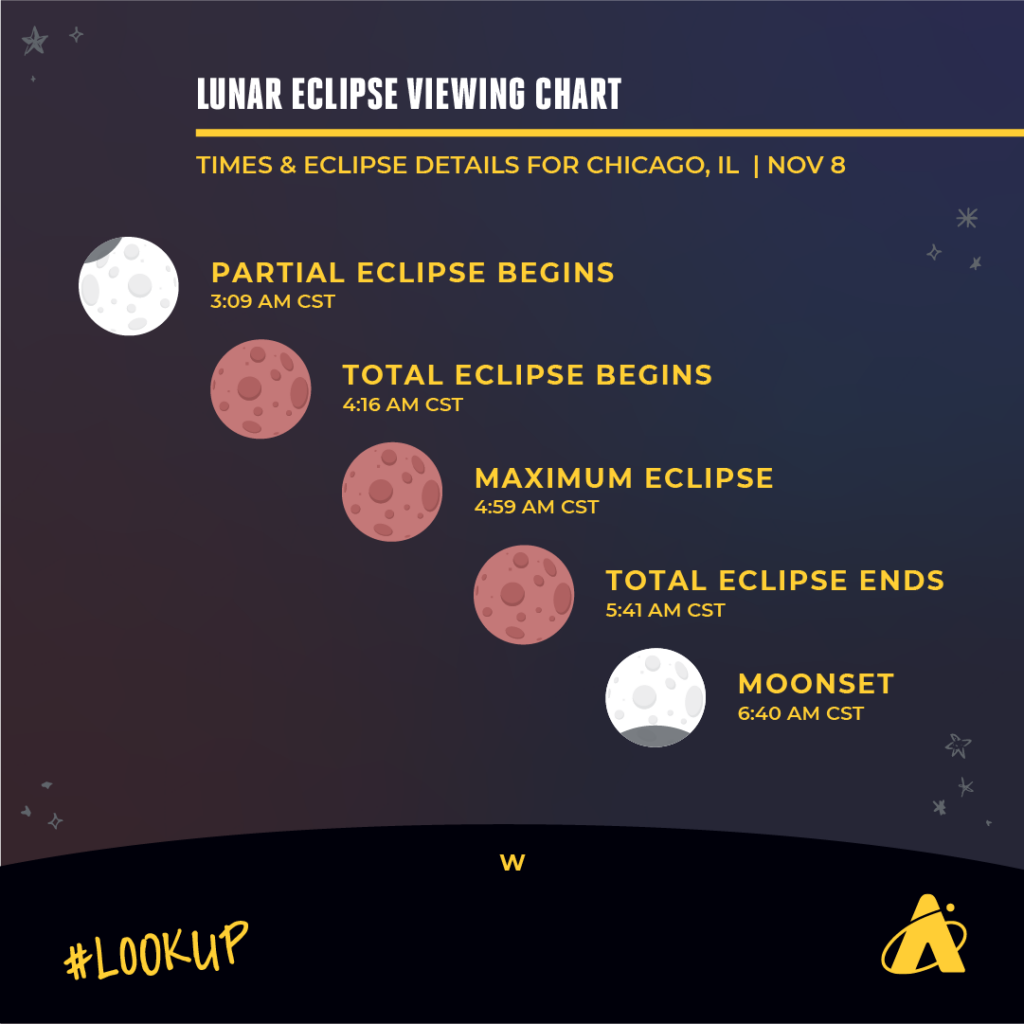Adler Skywatch: November 2022

Header Image: Total lunar eclipse on July 7, 2018.
Here’s your stargazing guide for November 2022 to help you spot planets and celestial events—including a total lunar eclipse visible in Chicago!
Time To Set Your Clocks Back

Daylight Saving Time ends on November 6, at 2:00 am local time. This is the day to set your clocks back one hour, to account for the hour we lost when we started Daylight Savings on March 13. This time-shift also affects the rise- and set-times of the planets in the descriptions below.
Planet Parade
Despite the time-shift, this month the planets Jupiter and Saturn are readily visible in the southeast skies about an hour after sunset. The two planets are brighter than the nearby stars, so they are easy to spot. Jupiter will likely catch your eye first, since it’s much brighter than any star in the night sky. About 40 degrees west of Jupiter is Saturn. To measure 40 degrees in the sky, hold out your hands at arms’ length and stretch out your fingers as though you were gesturing someone to “Stop”. The width of two hands together, from left-pinky finger to right-pinky finger, is roughly 40 degrees.
On November 1, a waxing gibbous Moon is near Saturn; and on November 4, a slightly bigger waxing gibbous Moon is near Jupiter. Saturn sets in the west-southwest around 11:00 pm Central Daylight Time at the start of the month and around 9:30 pm Central Standard Time by month’s end. Jupiter sets closer to west about 4:00 am CDT early in the month, and shortly after midnight Standard Time by month’s end.
The planet Mars is brighter than minus-one magnitude this month, so it’s easy to spot. It rises in the east-northeast soon after 8:00 pm CDT on November 1, and by 6:00 pm CST by the end of the month. Similar to last month’s planetary positioning, Mars appears to form a right-triangle with two bright red-giant stars. Less than 20 degrees south is Betelgeuse, in the constellation Orion; and less than 20 degrees west is Aldebaran, in the constellation Taurus. Mars easily outshines both stars. The evening of November 10 and in the early-morning darkness of November 11, Mars appears only about three degrees away from a waning gibbous Moon. Early in the month, the planet is about 45 degrees above the western horizon when it starts to fade in morning twilight. But later in the month, with the Sun rising later each morning, Mars remains visible a little longer and fades away barely 20 degrees above the west-northwest horizon.
Mars, Jupiter, and Saturn are all outside Earth’s orbit around the Sun. The planets inside Earth’s orbit, Mercury and Venus, appear too close to the Sun in the sky for safe viewing this month.
November 2022 Total Lunar Eclipse

If skies are clear, Chicagoland gets to see a total lunar eclipse during the early-morning darkness of the November 8. Unlike a solar eclipse, a lunar eclipse lasts a long time—in this case, totality lasts over an hour. Lunar eclipses also can be viewed from a wider area than solar eclipses. Finally, although it’s not as showy as a solar eclipse, you can see a lunar eclipse without special viewing equipment. Watching a full Moon turn red is quite a show!
In the Chicago area, the penumbral eclipse—when Earth’s faint outer shadow begins to creep across the lunar disk—starts just after 2:00 am CST. You may (or may not) notice a slight dimming of part of the Moon. The partial phase of the eclipse—when Earth’s deeper, inner shadow touches the Moon—starts at 3:09 am. The total phase—when the shadow completely covers the Moon—starts at 4:16 am. Often the Moon starts to turn reddish during the partial phase, and becomes entirely red during the total phase. Totality ends at 5:41 am, and the eclipse returns to partial-phase. By this time the Moon is very close to the west-northwest horizon. In fact, in the Chicago area, the Moon sets at 6:40 am just before the end of the eclipse’s partial phase. Let’s hope for clear skies, because the next total lunar eclipse visible from Chicago doesn’t occur until March of 2025.
Read our blog, “Solar Eclipses and Lunar Eclipses Explained,” for more information on the different phases of a total lunar eclipse.
Moon Phases
First Quarter Moon: November 1
Full Moon: November 8
Last Quarter Moon: November 16
New Moon: November 23
First Quarter Moon: November 30
Please note that these descriptions are for the Chicago area, using Central time.
Learn From Our Astronomy Educators
Watch exclusive live episodes of Sky Observers Hangout throughout the year on our YouTube channel! Learn how to observe upcoming cosmic happenings, enhance your astrophotography skills and see celestial objects through a telescope virtually with our astronomy educators. On November 8 at 3:00 am, our astronomy educators will be online to answer your questions about eclipses, explain how lunar eclipses happen, and give you stargazing tips on where you can spot the last lunar eclipse of 2022 in your sky as it’s happening. If the weather permits, we’ll even show you camera views of the eclipse LIVE! Don’t miss this very special episode of Sky Observers Hangout!
Subscribe To Skywatch Wednesday This November
Tour the night sky with the Adler Planetarium’s Theaters Manager Nick, who uses cutting-edge visualizations, NASA images, and astrophotography to show you what you can see in the night sky throughout the year.






